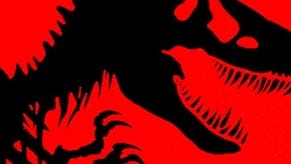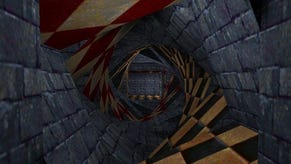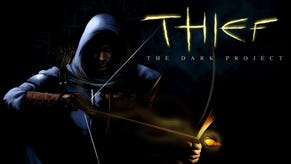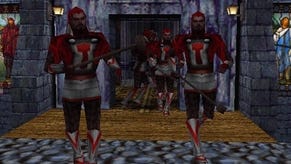Retrospective: Thief The Dark Project
The artful dodger.
It's the difficulty levels. That's what I love most about Thief. Looking Glass's genre-exploding first-person sneaker epic is an incredible work for many reasons, but I think it's best summarised by the difficulty levels.
Garrett, a master thief, works independently of the three societal groups that populate the game's expansive city. He's a loner, trained by the Keepers, but has long since abandoned them to pursue his own interests. Your first adventure is to break into Lord Bafford's Manor to steal his jewelled sceptre.
But here's the thing: On the Normal setting you're charged with successfully breaking into the building and finding the sceptre. Hard raises the stakes in more predictable ways such as having to escape the manor once the prize is stolen, and asking you to loot 350 gold pieces worth of items while you're there. But it's the final requirement that's significant. "Don't kill any of the servants; they're harmless." Bring it up to Expert and now you're tasked with getting 700 gold, but also: "Don't kill anyone while you do the job. No servants, no guards, no pets... no one."
It's this that captures the spirit, the essence of this most extraordinary game. This is a game where turning the difficulty up reduces the number of enemies you have to kill. Certainly it also increases the number of guards (but slightly and smartly, never feeling unfair or unrealistic), and repositions them into more strategic patrol routes. But it doesn't make your weapons less effective, or raise enemy hit-points, or artificially hinder you in any 'gamey' way. It simply asks you to be a better, subtler, smarter thief.
This particular phrase from one Expert mission briefing says it all perfectly: "Violence is the mark of the amateur. Don't kill anyone."
Out of darkness
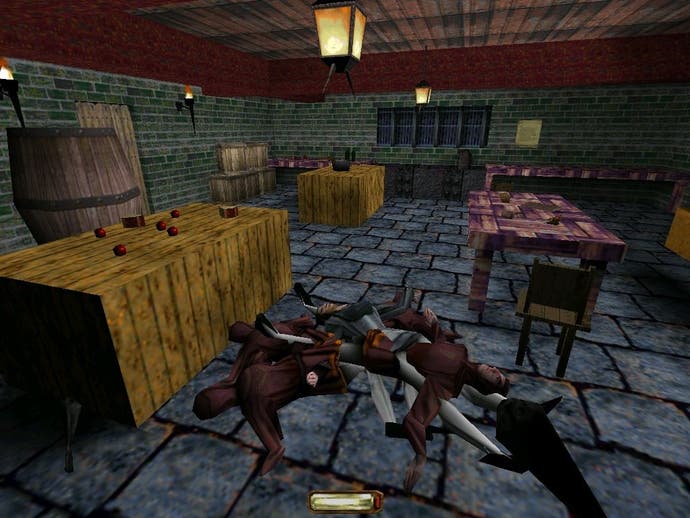
Well, actually, what I love most about Thief is the darkness. I love making the room dark before I play. Lots of games have that gamma check at the beginning, asking you to make sure the logo is barely visible in the box or whichever, but it's rarely of much importance. With Thief you tape the curtains to the window frames and stuff socks in the crack under the door.
I love entering a heavily guarded location, crouching in a safely shadowed corner, then snuffing the wall-mounted torches with a couple of water arrows. In the darkness I make quick methodical work of the patrolling guards, thwacking them over the back of the head with my trusted blackjack, and quickly depositing their unconscious bodies in a secluded, neat pile. Then having the safe run of the place, robbing every chest, shelf and hidden lockbox.
The use of lighting was remarkable in 1998, and still feels special 11 years later. Finding a shadow, watching your light meter fade to that comforting dark green, and waiting for your victim to stroll past - it's a feeling of incredible power, but power without armoured rifles or rocket launchers. Needing to pass through a room lit by non-extinguishable lamps, powered by this steampunk Middle Ages' mysterious magic, creates a sensation of helplessness, the nearest dreary corner looking homely and welcoming. The more you play, the more you crave the darkness, until you find yourself flinching when walking into your fluorescently lit kitchen, or instinctively picking the darkest path when walking home in the evening.
Rugged gaming

But of course it's the carpets I love most about Thief. After the light, the second most important aesthetic character in the game is the floor. Of how many games could you write that sentence? You're always acutely aware of what you're standing on. Tiled, stone floors make up most of the streets and buildings you encounter, loudly registering your clip-clop footsteps. (It does seem that if Garrett really wanted to be a master thief, he might consider not wearing the high-heel shoes that can only be responsible for the ludicrous noise he makes while running.)
Exaggerated it might be, but it allows you to register exactly how much of a racket you're making. Crouched down, inching forward, disguising your footsteps can be astonishingly difficult. And then you spot the worst sights of them all: gravel or ceramic tiles. Each makes such a noise, and if you're out of moss arrows to soften your step, drastic long-cuts may need to be taken.
But then, there it is: carpet. Sweet, blessed carpet. On carpet Garrett can run, jump and be merry, producing nothing more than a soft scuffing. Sneaking up on the enemy is a cinch, picking their pockets and being long gone before they've a clue you were ever there. Oh, heavens, a completely dark carpeted room: sheer bliss.
Shadow conspiracy
No, obviously what I really love most is the story. Thief's mythology is just extraordinary. Perhaps that's what most surprised me going back to it. The people at Looking Glass already had a reputation for their ability to tell a story with grace and subtlety. System Shock and Ultima Underworld 2 had proved this four years earlier. But it was Thief that demonstrated them as the masters of this art. The mythology that enwraps the game is massively complex, and yet almost invisible.

